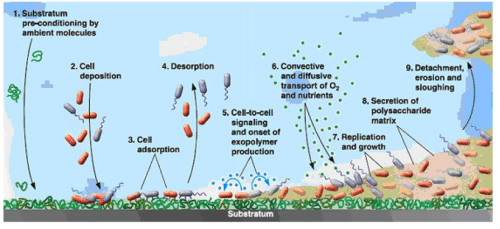Looking Inside a Biofilm
Biofilms are communities of microorganisms that attach to the wound surface encasing themselves in an extracellular polysaccharide matrix.1 Because multiple types of organism can exist synergistically within a biofilm, often displaying remarkable antibacterial resistance, biofilms can present a real barrier to wound healing.2
Biofilm Formation
The complex molecular nature of a biofilm is not yet fully understood. However, considerable research into the area has shown that biofilm formation involves a sequence of discrete steps, as shown in the diagram below.2 Processes currently known to be involved in biofilm formation include: 1. pre-conditioning of the adhesion surface by ambient macromolecules present; 2. transport of planktonic cells to the surface; 3. adsorption of cells at the surface; 4. desorption of reversibly adsorbed cells; 5. irreversible adsorption of bacterial cells at a surface; 6. production of cell–cell signaling molecules; 7. transport of substrates to and within the biofilm; 8. substrate metabolism by the biofilm-bound cells and transport of products out of the biofilm. These processes are accompanied by cell growth, replication, and EPS production.3
Biofilm Attachment
A number of different variables affect the attachment of microorganisms to surfaces and the subsequent biofilm development. In general, biofilm attachment will occur most readily on surfaces that are rougher and more hydrophobic and where there is a high nutrient concentration.
Quorum Sensing
The driving force in the development of a bacterial community such as a biofilm is a system of self-organization and cooperation among cells through a process known as quorum sensing.3,4 Quorum sensing is a form of environmental signaling that allows bacteria to monitor and respond to their own population densities. The bacteria produce an organic signal, depending on the cell density, which induces expression of certain genes and/or physiological changes in neighboring cells. Oligopeptides and N- acylhomoserine lactones are major molecules involved in intra-specific communication in Gram-positive and Gram-negative bacteria, respectively, whereas boronated diester molecules are involved in inter-specific communication across both Gram-positive and Gram-negative bacteria.
Processes governing biofilm formation3

Figure reproduced from: Simões M, Simões LC, Vieira MJ.
A review of current and emergent biofilm control strategies. LWT – Food Sci Tech 2010; 43: 573-585
If you find the fascinating topic of self-organization within a bacterial community to form a biofilm of interest, you may wish to consider researching the topic further as part of your ongoing professional development.
Learn More With Our Wound Care Education Options
Interested in learning more about wound care and certification? Browse through our wound care certification courses for information on our comprehensive range of education options to suit healthcare professionals across the full spectrum of qualifications and experience.
References
- Yang L, Liu Y, Wu H et al. Current understanding of multi-species biofilms. Int J Oral Sci 2011; 3: 75-81.
- Myers BA. Wound management principles and practice. 2nd ed. Upper Saddle River, NJ: Pearson; 2008.
- Simões M, Simões LC, Vieira MJ. A review of current and emergent biofilm control strategies. LWT – Food Sci Tech 2010; 43: 573-585.
- Chen Li and Wen Y-m. The role of bacterial biofilm in persistent infections and control strategies. Int J Oral Sci. 2011; 3:66-73.

Hi Charles,
Yes, we do offer a payment plan. Please conact [email protected] for further details. We look foward to having you as a student.